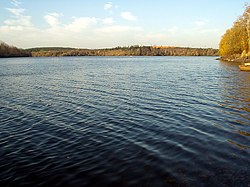Lough Oughter
| Lough Oughter | |
|---|---|

Lough Oughter in Killykeen
|
|
| Location | County Cavan |
| Coordinates | 54°01′01″N 7°23′18″W / 54.01694°N 7.38833°WCoordinates: 54°01′01″N 7°23′18″W / 54.01694°N 7.38833°W |
| Type | Eutrophic Glacial lake between drumlins. |
| Primary inflows | from various springs and streams |
| Primary outflows | River Erne Atlantic Ocean, Ballyshannon |
| Designation | Ornithological, botanical, zoological interest |
| Max. length | 12 km (7.5 mi) |
| Max. width | 10 km (6.2 mi) |
| Surface area | 8,931 ha (22,070 acres) |
| Frozen | winter of 2010/2011 |
Lough Oughter (Irish: Loch Uachtair) is a lake, or complex of lakes, in County Cavan covering approximately 8931 hectares. It is on the River Erne, and forms the southern part of the Lough Erne complex. The lakes are bounded roughly by Belturbet in the north; Cavan Town to the east; Crossdoney to the south and Killeshandra to the west.
Scientific evaluations consider the Lough Oughter area as a whole as the best inland example of a flooded drumlin landscape in Ireland and has many rich and varied biological communities. Nowhere else in the country does such an intimate mixture of land and water occur over a comparable area, and many of the species of wetland plants, some considered quite commonplace in Lough Oughter and its associated loughs, are infrequent elsewhere. The number of whooper swans which winter in the area represents about 3% of the total European population while the lake also houses the largest concentration of breeding Great Crested Grebes in the Republic, having become almost extinct in the 19th century.
Lough Oughter has long been classed locally as an angling lake and is grossly under valued for its qualities as a potential venue for wildlife eco-tourism and education, is now designated as a suitable wetland for inclusion in the 'Ramsar List of Wetlands of International Importance'. Cavan County Council have stated: "It is recognized nationally and internationally as being of significant values not only for the country, but for humanity as a whole". It should also be noted that the Lough Oughter complex along with Killykeen Forest Park are designated Natura 2000 habitats, Special Areas for Conservation (SAC) and Special Protection Areas (SPA) under EU legislation. Lough Oughter is part of the UNESCO Marble Arch Caves Global Geopark.
The main threats to the quality of the site, according to scientific sources, are water polluting such as run-off from fertiliser and slurry applications and sewage discharge which have raised the nutrient status of some lakes to hypertrophic. Increased afforestation has resulted in some loss of wetland habitat and also loss of some feeding ground for wintering birds such as Greenland White-fronted Geese.
With their natural beauty and bio-diversity the Lough Oughter complex of lakes and wetlands make an ideal location for sustainable Ecotourism. The income can be significant and support livelihoods, locally and nationally. Wetlands provide other 'services', too, such as water, food, water purification, erosion control, etc., for the benefit of tourists and tourist accommodation. The income generated by tourism for national and local economies in and around wetlands can be substantial: the Broads in the UK supports the equivalent of 3,000 full-time jobs.
...
Wikipedia
